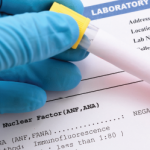NEW YORK (Reuters Health)—A new test provides rapid infliximab drug concentrations that enable immediate dosing adjustments, researchers from Belgium report.
“With this rapid test, our biggest wish is to persuade physicians to now perform and use infliximab measurements also in their own daily clinical practice, as many practical and organizational issues that went along with these measurements have now disappeared,” Dr. Thomas Van Stappen from Katholieke Universiteit Leuven tells Reuters Health.
“On top, the rapid test now allows clinicians to set the right, individualized dosing regimen at the same time a patient visits the hospital,” he says.
The trough concentration of infliximab has been linked to biological, clinical, and endoscopic outcomes, but the usual hospital laboratory assay is time-consuming and does not allow immediate dose optimization.
Dr. Van Stappen and colleagues developed a novel assay for rapid infliximab quantification, benchmarked to a reference infliximab ELISA. They determined infliximab concentration thresholds associated with mucosal healing following induction treatment in 29 anti-TNF-naïve patients initiating infliximab treatment for moderate to severe ulcerative colitis.
Results from the new assay showed very good correlation with ELISA results for samples withdrawn during induction and maintenance of infliximab treatment, the team reports in Clinical and Translational Gastroenterology, online Dec. 8.¹
Based on a comparison of infliximab levels between patients who experienced mucosal healing (n=13) and those who did not (n=16), the infliximab concentration threshold using the new assay appeared to be >=2.1 mcg/mL (sensitivity 100%, specificity 50%).
Patients with lower levels who did not initially have mucosal healing benefited from an intensified dose regimen, with three of four of these patients successfully completing two years of infliximab treatment.
Another new assay proved more sensitive for detecting anti-infliximab antibodies (34% of patients, 16% of samples) compared with an existing assay (14% of patients, 2% of samples).
Dr. Van Stappen highlighted two important applications of this new test in daily clinical practice.
“The first one would be to apply the rapid assay in patients receiving infliximab induction treatment, at Weeks 2, 6 and 14, as many research groups are clearly demonstrating that infliximab concentrations during induction treatment reflect the drug’s clinical effect,” he says.
“The second application of the rapid test would be in patients experiencing a flare during infliximab maintenance treatment,” he explains. “Way too often these patients are randomly dose intensified or switched to another drug, which is often not the right treatment for each patient. With a rapid infliximab test, clinicians can immediately determine whether the loss of response is due to low drug exposure, which can be caused by immunogenicity (warranting an anti-infliximab antibody measurement), or by other (non-disease) related mechanisms.”
